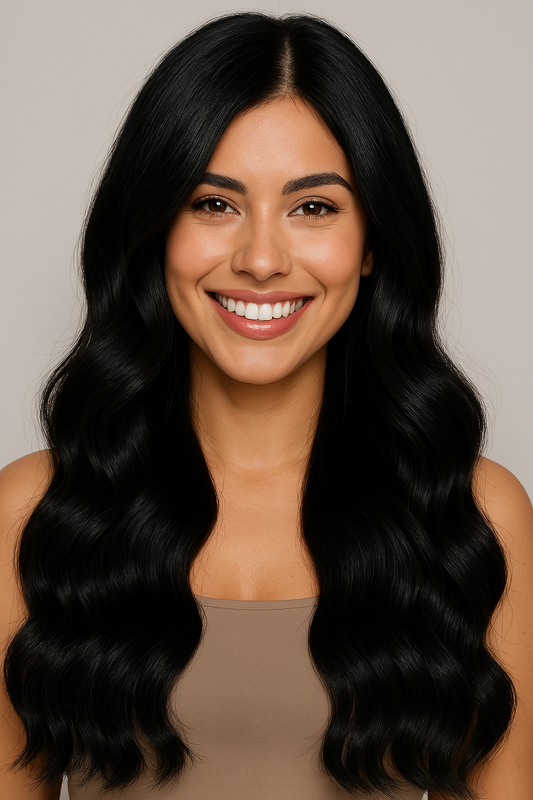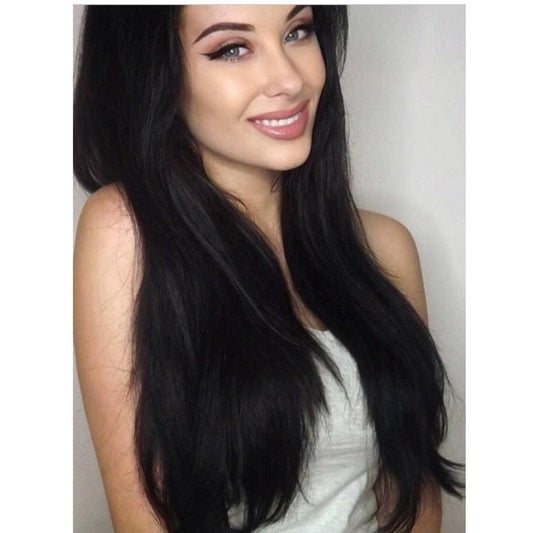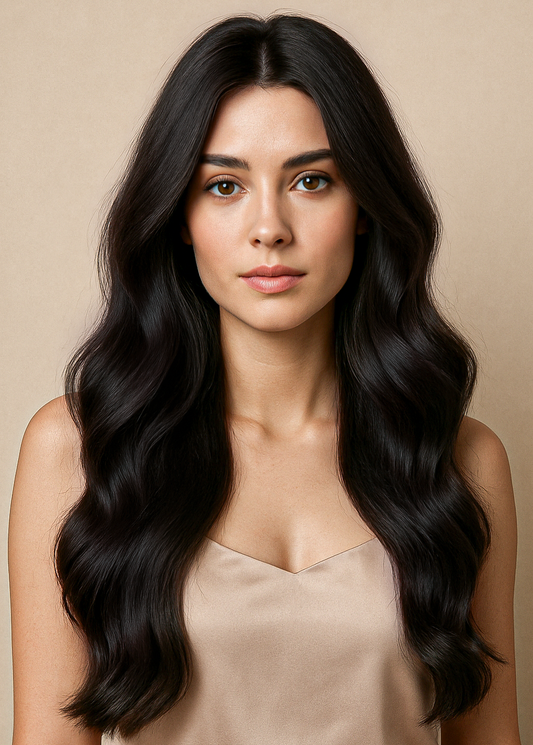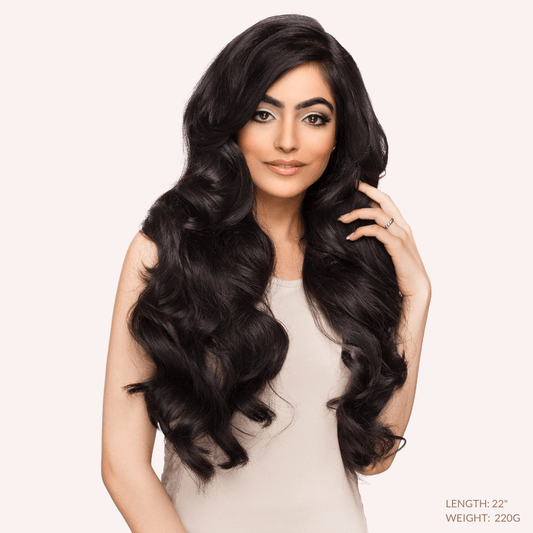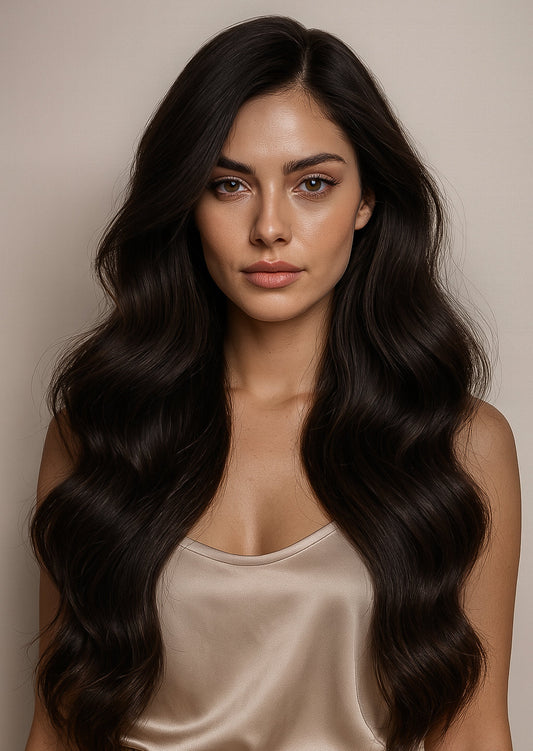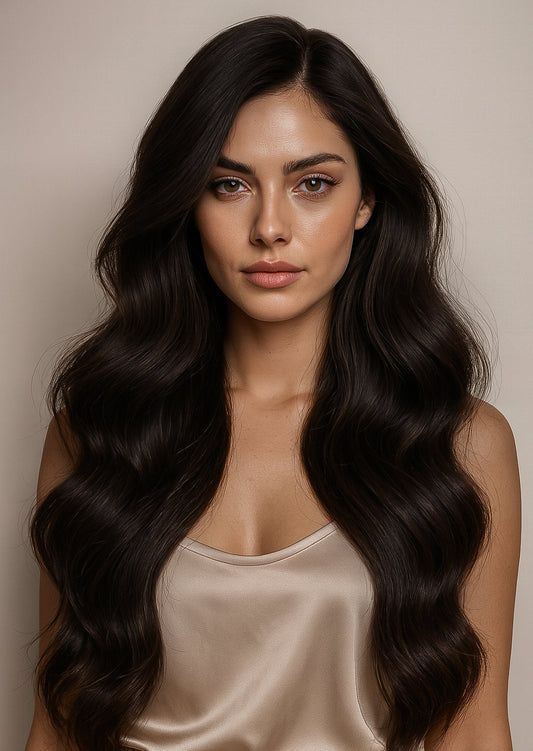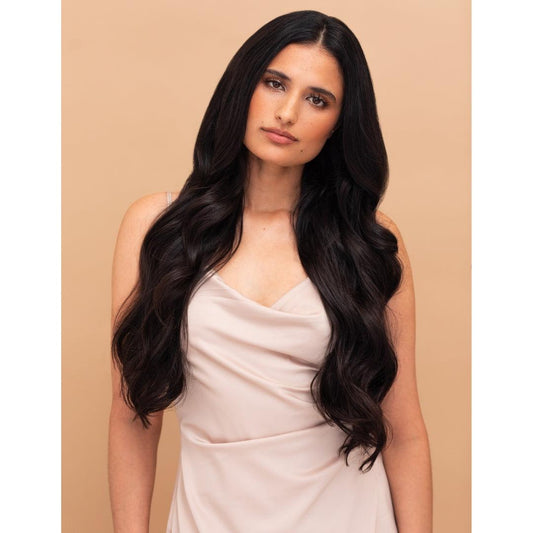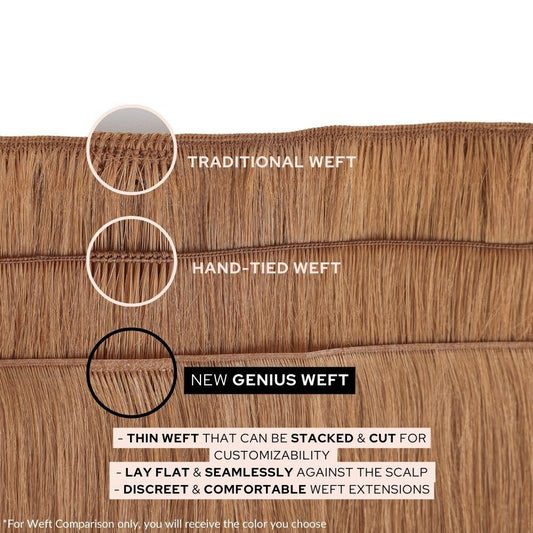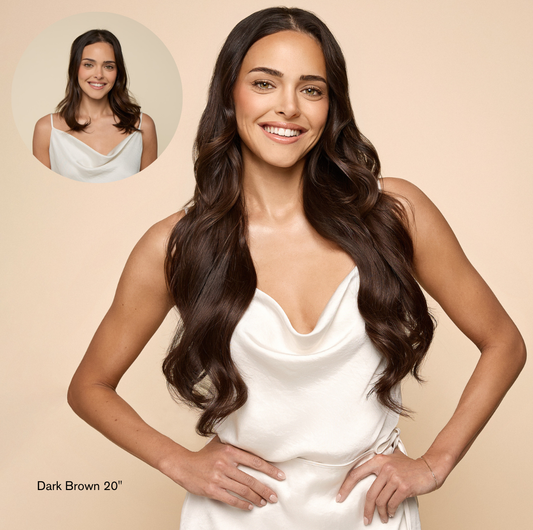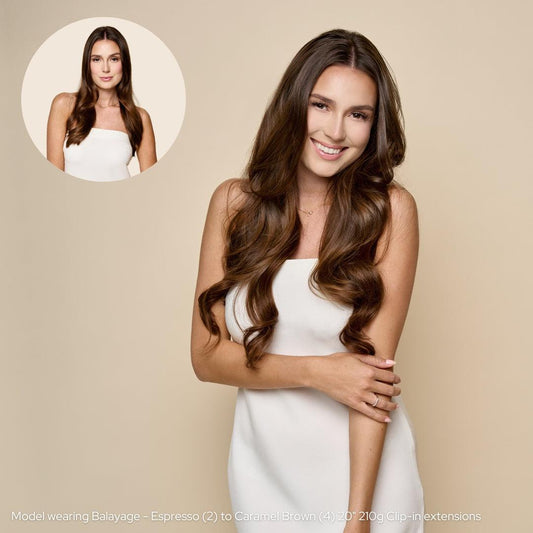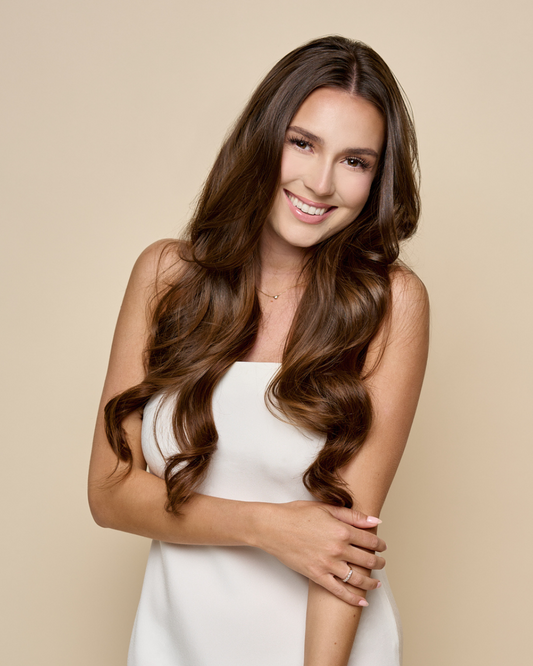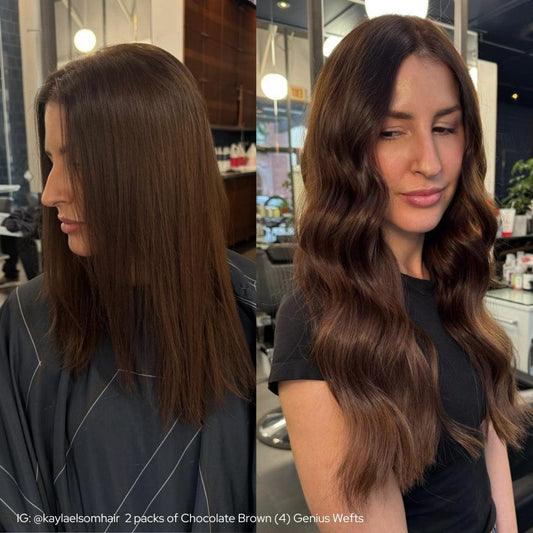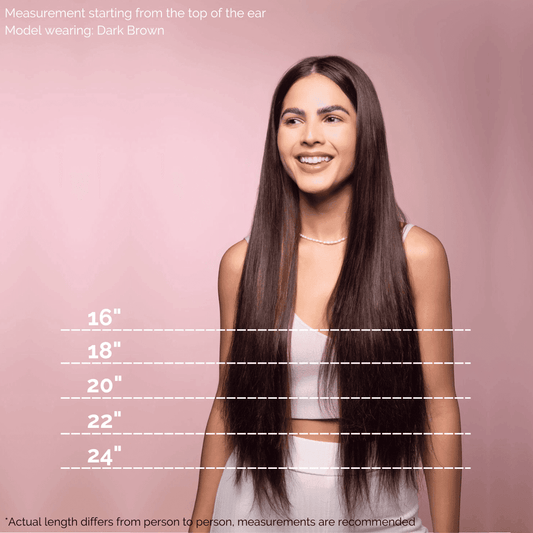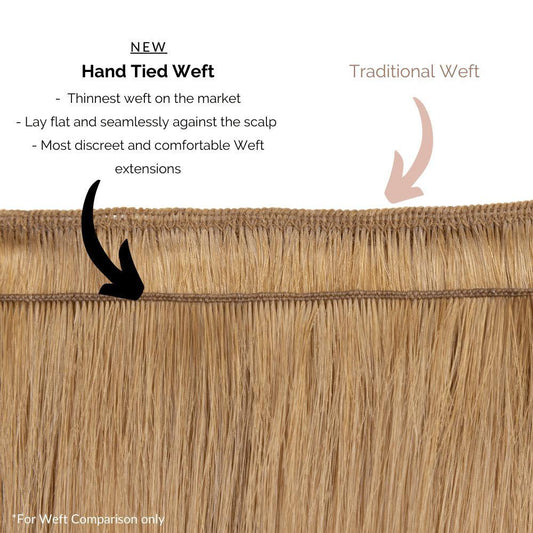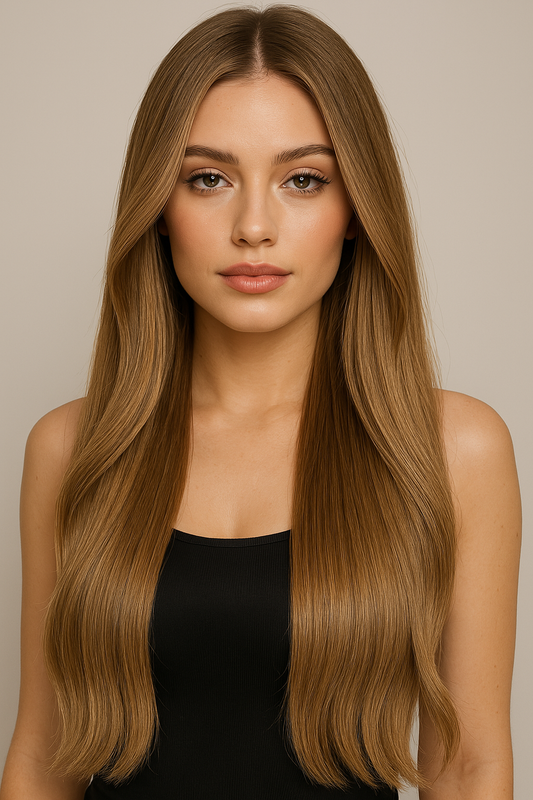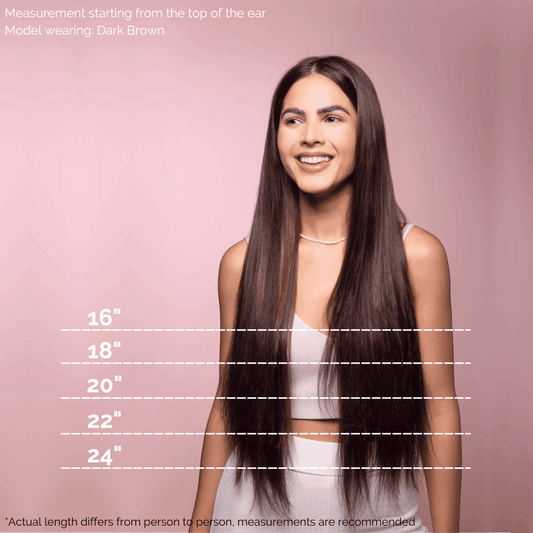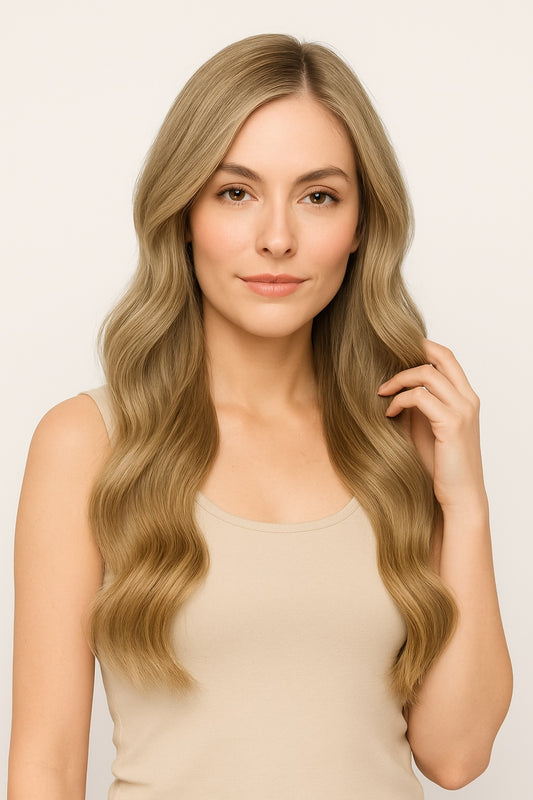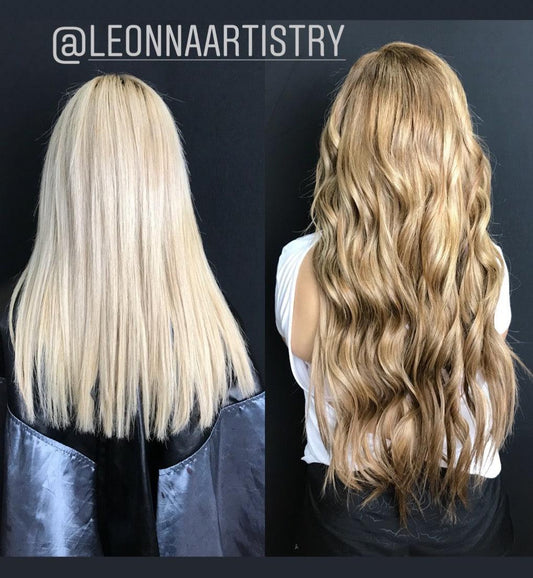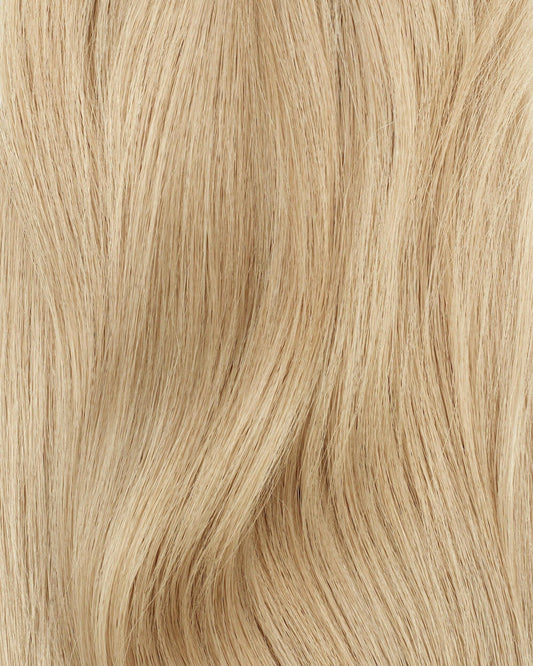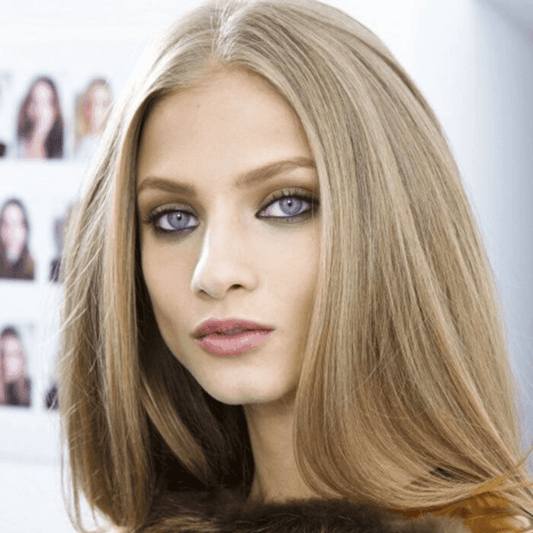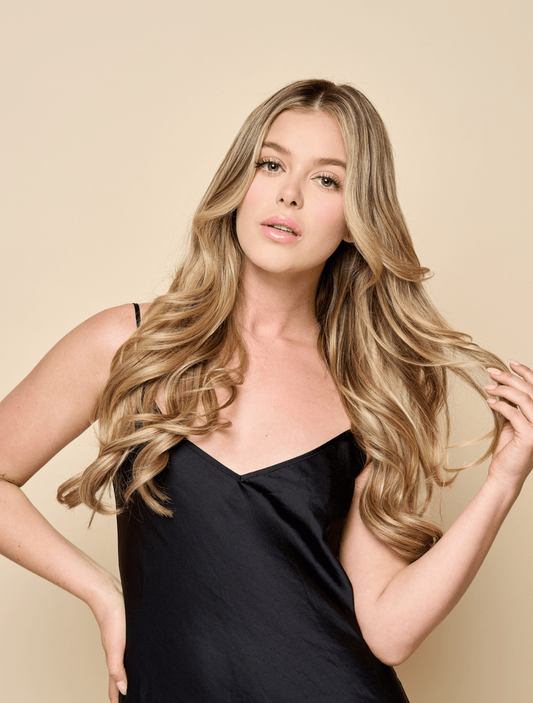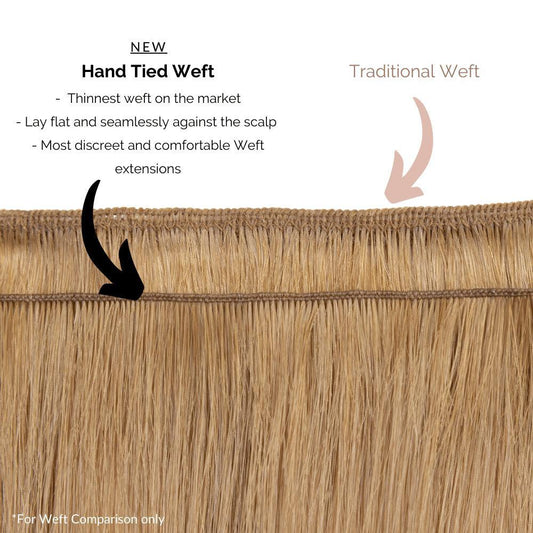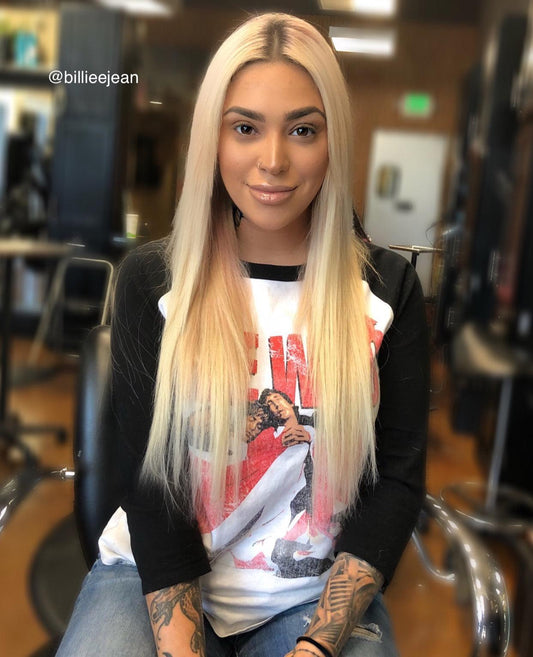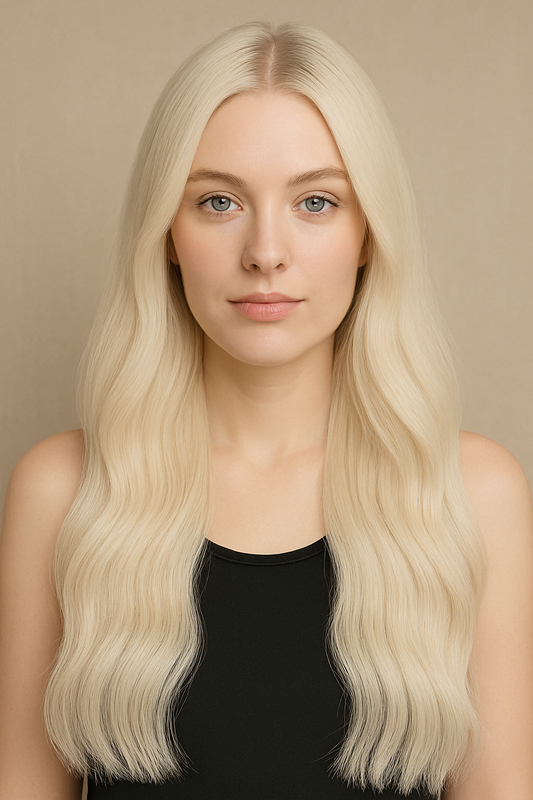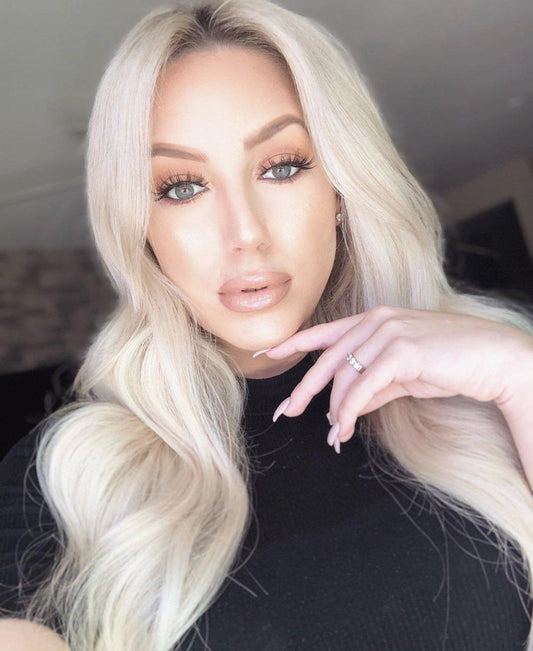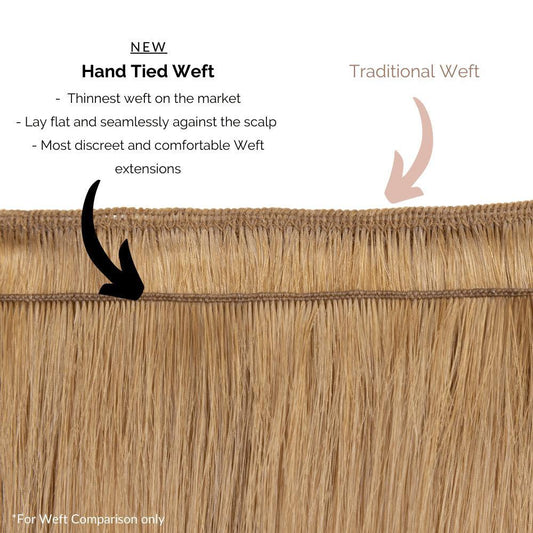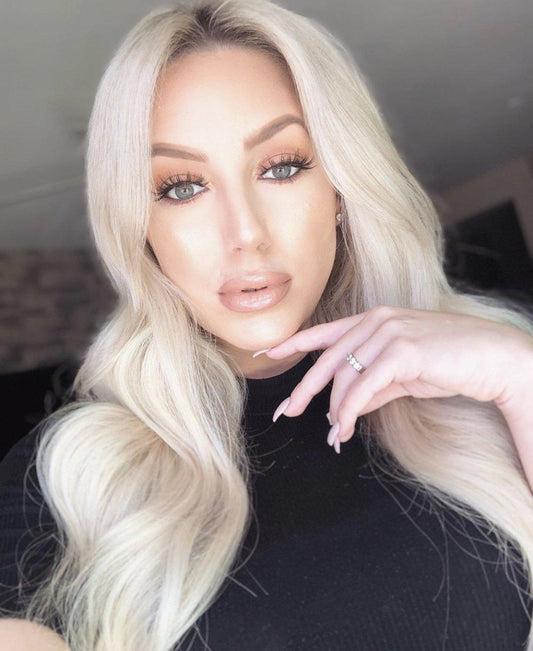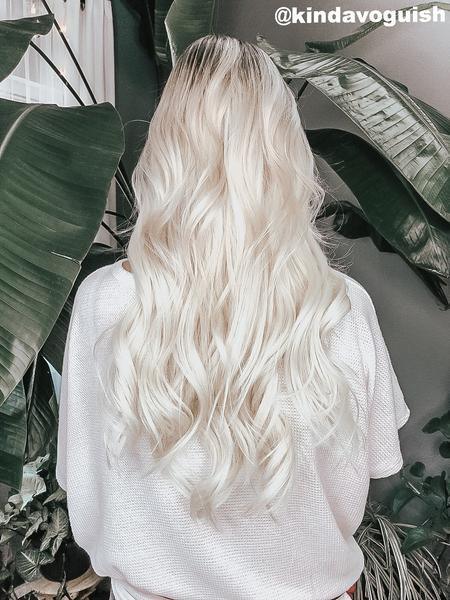Shop Weft Extensions by Type

Weave Hair Weft & Remy Hair Extensions

HAIR STYLING TOOLS
- Shop All
- 5-in-1 Curling Wand
- 3-in-1 Curling Wand
- Curling Wands (without Clamp)
- Curling Iron (with Clamp)
- Flat Iron - Straighteners
- Hair Dryers
- Tamanna Styling Set
- Styling Kits
CLIP HAIR EXTENSIONS
- Shop All Colors
- Jet Black (1)
- Off Black (1B)
- Soft Black (1C)
- Espresso (2)
- Dark Brown (2A)
- Medium Brown (2B)
- Caramel Brown (4)
- Ash Brown (8)
- Dirty Blonde (9/18)
- Beach Blonde (18/60)
- Ash Blonde (60)
- Blends/Highlights
- Ombre
TAPE HAIR EXTENSIONS
- Shop By Length
- Black Tapes
- Brown Tapes
- Medium Blonde Tapes
- Light Blonde Tapes
- All Blonde Tapes
- Red/Amber Tapes
- Rooted Tapes
- Ombre Tapes
- Highlight/Blend Tapes
- Color Match Assistance
- Tape Accessories
PERMANENT EXTENSIONS
-
Vendor:Traditional Weft Bundle
Jet Black (1) 100g Weft
5.0Rated 5.0 out of 5 stars14Regular price From $160 - $280Sale price $160 Regular priceUnit price / per$180Jet Black (1) 100g Weft$160$180$205$230$223$250$240$270$280$315Select Length: 16”Sale -
Vendor:Genius Weft
Jet Black (1) Genius Weft
4.7Rated 4.7 out of 5 stars19Regular price From $142 - $182Sale price $142 Regular priceUnit price / per$160Sale -
Vendor:Traditional Weft Bundle
Natural Black (#1A) 100g Weft
Regular price From $160 - $294Sale price $160 Regular priceUnit price / per$180Natural Black (#1A) 100g Weft$160$180$205$230$223$250$240$270$294$330Select Length: 16”Sale -
Vendor:Traditional Weft Bundle
Off Black (1B) 100g Weft
4.9Rated 4.9 out of 5 stars15Regular price From $160 - $294Sale price $160 Regular priceUnit price / per$180Off Black (1B) 100g Weft$160$180$205$230$223$250$240$270$294$330Select Length: 16”Sale -
Vendor:Genius Weft
Off Black (1B) Genius Weft
4.7Rated 4.7 out of 5 stars19Regular price From $142 - $182Sale price $142 Regular priceUnit price / per$160Sale -
Vendor:Traditional Weft Bundle
Soft Black (1B/C) 100g Weft
Regular price From $223 - $240Sale price $223 Regular priceUnit price / per$250Sale -
Vendor:Genius Weft
Soft Black (1B/C) Genius Weft
Regular price From $156 - $182Sale price $156 Regular priceUnit price / per$175Sale -
Vendor:Traditional Weft Bundle
Espresso (1C) 100g Weft
4.9Rated 4.9 out of 5 stars14Regular price From $160 - $280Sale price $160 Regular priceUnit price / per$180Espresso (1C) 100g Weft$160$180$205$230$223$250$240$270$280$315Select Length: 16”Sale -
Vendor:Genius Weft
Espresso (1C) Genius Weft
4.7Rated 4.7 out of 5 stars19Regular price From $142 - $182Sale price $142 Regular priceUnit price / per$160Sale -
Vendor:Traditional Weft Bundle
Dark Brown (2) 100g Weft
4.9Rated 4.9 out of 5 stars22Regular price From $160 - $280Sale price $160 Regular priceUnit price / per$180Dark Brown (2) 100g Weft$160$180$205$230$223$250$240$270$280$315Select Length: 16”Sale -
Vendor:Genius Weft
Dark Brown (2) Genius Weft
4.7Rated 4.7 out of 5 stars19Regular price From $142 - $182Sale price $142 Regular priceUnit price / per$160Sale -
Vendor:Traditional Weft Bundle
Ombre Espresso (#1C) to Chestnut Brown (#6C) 100g Weft
5.0Rated 5.0 out of 5 stars3Regular price From $223 - $240Sale price $223 Regular priceUnit price / per$250Ombre Espresso (#1C) to Chestnut Brown (#6C) 100g Weft$223$250$240$270Select Length: 20”Sale -
Vendor:Traditional Weft Bundle
Mocha Brown (3) 100g Weft
4.8Rated 4.8 out of 5 stars6Regular price From $160 - $280Sale price $160 Regular priceUnit price / per$180Mocha Brown (3) 100g Weft$160$180$205$230$223$250$240$270$280$315Select Length: 16”Sale -
Vendor:Genius Weft
Mocha Brown (3) Genius Weft
4.7Rated 4.7 out of 5 stars19Regular price From $142 - $182Sale price $142 Regular priceUnit price / per$160Sale -
Vendor:Traditional Weft Bundle
Caramel Brown (#5B) 100g Weft
5.0Rated 5.0 out of 5 stars4Regular price From $160 - $240Sale price $160 Regular priceUnit price / per$180Caramel Brown (#5B) 100g Weft$160$180$205$230$223$250$240$270Select Length: 16”Sale -
Sold outVendor:Hand-Tied Weft
Caramel Brown (#5B) Hand-Tied Weft | Final Sale
4.9Rated 4.9 out of 5 stars19Regular price From $142 - $182Sale price $142 Regular priceUnit price / per$160Caramel Brown (#5B) Hand-Tied Weft | Final Sale$142$160$160$180$174$195$182$205Select Length: 16" (45g)Sold out -
Vendor:Genius Weft
Caramel Brown (5B) Genius Weft
4.7Rated 4.7 out of 5 stars19Regular price From $142 - $182Sale price $142 Regular priceUnit price / per$160Sale -
Vendor:Traditional Weft Bundle
Cool Brown (#10C) 100g Weft
4.8Rated 4.8 out of 5 stars4Regular price From $160 - $240Sale price $160 Regular priceUnit price / per$180Sale -
Vendor:Traditional Weft Bundle
Ash Brown (#9) 100g Weft
5.0Rated 5.0 out of 5 stars11Regular price From $160 - $240Sale price $160 Regular priceUnit price / per$180Sale -
Vendor:Traditional Weft Bundle
Dirty Blonde (19C) 100g Weft
5.0Rated 5.0 out of 5 stars14Regular price From $160 - $240Sale price $160 Regular priceUnit price / per$180Dirty Blonde (19C) 100g Weft$160$180$205$230$223$250$240$270Select Length: 16”Sale -
Vendor:Genius Weft
Dirty Blonde (19C) Genius Weft
4.7Rated 4.7 out of 5 stars19Regular price From $151 - $182Sale price $151 Regular priceUnit price / per$170Sale -
Vendor:Traditional Weft Bundle
Bronde (15C) 100g Weft
4.8Rated 4.8 out of 5 stars4Regular price From $160 - $240Sale price $160 Regular priceUnit price / per$180Sale -
Vendor:Traditional Weft Bundle
Beige Blonde Highlights (P10/613) 100g Weft
Regular price From $223 - $240Sale price $223 Regular priceUnit price / per$250Sale -
Vendor:Traditional Weft Bundle
Golden Blonde (22B) 100g Weft
4.8Rated 4.8 out of 5 stars4Regular price From $160 - $240Sale price $160 Regular priceUnit price / per$180Golden Blonde (22B) 100g Weft$160$180$205$230$223$250$240$270Select Length: 16”Sale -
Sold outVendor:Hand-Tied Weft
Golden Blonde (#22B) Hand-Tied Weft | Final Sale
4.9Rated 4.9 out of 5 stars19Regular price From $142 - $196Sale price $142 Regular priceUnit price / per$160Golden Blonde (#22B) Hand-Tied Weft | Final Sale$142$160$165$185$178$200$196$220Select Length: 16" (45g)Sold out -
Vendor:Genius Weft
Golden Blonde (22B) Genius Weft 22" 55g
4.7Rated 4.7 out of 5 stars19Regular price $182Sale price $182 Regular priceUnit price / per$205Sale -
Vendor:Traditional Weft Bundle
Golden Beach Blonde (#23) 100g Weft
5.0Rated 5.0 out of 5 stars13Regular price From $160 - $240Sale price $160 Regular priceUnit price / per$180Golden Beach Blonde (#23) 100g Weft$160$180$205$230$223$250$240$270Select Length: 16”Sale -
Vendor:Genius Weft
Golden Beach Blonde (23) Genius Weft
4.7Rated 4.7 out of 5 stars19Regular price From $151 - $182Sale price $151 Regular priceUnit price / per$170Golden Beach Blonde (23) Genius Weft$151$170$165$185$182$205Select Length: 18" 45gSale -
Vendor:Traditional Weft Bundle
Platinum Ash Blonde (1002) 100g Weft
4.9Rated 4.9 out of 5 stars13Regular price From $160 - $240Sale price $160 Regular priceUnit price / per$180Platinum Ash Blonde (1002) 100g Weft$160$180$205$230$223$250$240$270Select Length: 16”Sale -
Sold outVendor:Hand-Tied Weft
Platinum Ash Blonde (#1002) Hand-Tied Weft | Final Sale
4.9Rated 4.9 out of 5 stars19Regular price From $142 - $196Sale price $142 Regular priceUnit price / per$160Platinum Ash Blonde (#1002) Hand-Tied Weft | Final Sale$142$160$165$185$178$200$196$220Select Length: 16" (45g)Sold out -
Vendor:Genius Weft
Platinum Ash Blonde (1002) Genius Weft
4.7Rated 4.7 out of 5 stars19Regular price From $151 - $182Sale price $151 Regular priceUnit price / per$170Platinum Ash Blonde (1002) Genius Weft$151$170$165$185$182$205Select Length: 18" 45gSale -
Vendor:Traditional Weft Bundle
White Blonde (60B) 100g Weft
5.0Rated 5.0 out of 5 stars10Regular price From $160 - $294Sale price $160 Regular priceUnit price / per$180White Blonde (60B) 100g Weft$160$180$205$230$223$250$240$270$294$330Select Length: 16”Sale
FAQs
How do I care for my traditional weave weft?
To care for a traditional weave weft, wash it regularly with a gentle shampoo and conditioner. Avoiding excessive heat styling and protecting the hair when swimming or exercising is essential. Additionally, it's recommended to moisturize the hair regularly to prevent dryness and breakage.
Can I swim or exercise with a traditional weave weft?
Yes, you can swim and exercise with a traditional weave weft, but protecting the hair by wearing a swim cap or tying it up in a ponytail is essential. It's also recommended to wash and condition the hair after swimming or exercising.
Can I remove a traditional weave weft by myself?
It's important to have a professional stylist remove a traditional weave weft to avoid damaging the hair or scalp. If you attempt to remove it yourself, you may pull or cut the hair, which can cause pain, discomfort and damage to the weave wefts.
Weave Hair Weft & Remy Hair Extensions
Bombay Hair’s Weave Hair Weft & Remy Hair Extensions blend seamlessly with your natural hair, from straight hair to wavy hair. Whether you prefer a sleek, straight texture or luxurious waves, our real human hair extensions can be blended to match any hairstyle. With proper care, our human hair extensions provide unmatched volume, body, and style that lasts longer.
What Are Hair Weaves And How To Weave Hair?
Hair weaves are a type of hair extensions that are used to add length, volume, or style to a person's natural hair. They are typically made from human hair and are available in a variety of textures, colors, and lengths. Hair weaves are sewn, glued, or clipped onto the natural hair, which has been braided or prepared in some other way to provide a secure base for the weave. The weaving process can be time-consuming and may require the skills of a professional hairstylist.
Hair weaves are popular because they can provide a drastic hairstyle change without cutting or treating your own hair. They can be used to create a wide variety of hairstyles, from long, flowing locks to dramatic updos. Hair weaves also offer a protective style option, as they shield natural hair from potential damage caused by environmental factors, heat styling, or harsh chemicals. However, it's important to note that proper care and maintenance are still required to keep both the weave and the natural hair underneath in good condition.
Types of Hair Weaves
Hair weaves come in several distinct types, each with its own unique characteristics and benefits. By understanding these different types, one can make an informed choice that best suits their personal style and hair care needs.
- Sew-In Weaves: These weaves are installed across your full head by braiding the natural hair into cornrows and then sewing the hair wefts onto the braids using a needle and thread.
- Bonded Weaves: Also known as glue-in weaves, bonded weaves involve attaching hair wefts to the natural hair using adhesive glue.
- Clip-In Weaves: Clip-in weaves offer a temporary option for adding length, volume, or color to the hair without permanent installation. These wefts are attached to the natural hair using small clips.
- Fusion or Pre-Bonded Weaves: Fusion weaves involve attaching individual hair strands or small bundles to the natural hair using a heating tool to bond the extensions.
- Micro-Link or Micro-Bead Weaves: Micro-link weaves use small metal rings or beads to attach hair wefts to small sections of the natural hair, offering a method that doesn't involve braiding or gluing.
- Tape-In Weaves: Tape-in weaves involve attaching hair wefts to the natural hair using double-sided tape, providing a semi-permanent option that lies flat against the scalp.
- Net Weaves: Net weaves involve sewing a net onto the braided natural hair and then sewing the hair wefts onto the net, providing added security and support for longer-lasting wear.


The Processing Steps for Non-Remy Hair Extensions
1. Sew-In Weaves: This type of weave is one of the most common. It involves the stylist braiding the natural hair into a series of cornrows, then using a needle and thread to sew the weave into the braids. Sew-in weaves are often favored for their durability and the versatility they offer in styling.
2. Glue-In Weaves: As the name suggests, glue-in weaves are attached with special hair adhesive. This is a quick method of attachment, but it can be damaging to the natural hair if not removed properly. Glue-in weaves are usually recommended for short-term wear such as a special event.
3. Clip-In Weaves: Clip-in weaves are the most user-friendly type of hair weave. They come with clips attached that can easily be clipped onto the natural hair. This type of weave is perfect for those who want to add length or volume to their hair on a temporary basis.
4. Fusion Weaves: Fusion weaves are the most permanent type of hair weave. They are attached to small sections of natural hair via keratin bonding. This method offers the most natural look but can be quite costly and time-consuming to apply.
5. Net Weaves: Net weaves utilize a net that is sewn over the braids, onto which the weave is attached. This type of weave can provide a break for the natural hair and aid in its overall health and growth.
Choosing the right type of hair weave depends largely on your lifestyle, hair condition, and personal preference. Each type offers its own set of benefits and drawbacks, and it's important to consider all these factors before making a decision. Remember, while hair weaves can offer a fantastic way to change up your look and protect your natural hair, proper care is essential to maintain a healthy head of hair underneath. Choose wisely and enjoy the world of possibilities that hair weaves open up!
What is Weaving Hair?
Weaving hair, also known as hair weaving or hair extensions, is a technique used to add length, volume, or different hairstyles to a person's natural hair. This method involves attaching artificial or human hair to the individual's existing hair. There are various methods and types of hair extensions, including:
Sewing or Braiding
Sewing or braiding is a common method used in the application of hair weaves. This technique, often employed for sew-in weaves, involves the natural hair being tightly braided into cornrows or other patterns on the scalp. The hair extensions are then sewn onto the braids using a needle and thread, providing a secure base for the weave. This method is highly favored for its durability and ability to support various hairstyles.


Clip-In Extensions
Clip-in extensions are a popular type of hair weave for all hair types, from bone straight to curly, due to their ease of use and temporary nature. These extensions come with small clips attached that can be quickly and securely fastened to your natural hair. Clip-ins are perfect for those who wish to add length, volume, or a pop of color to their hair without committing to a more permanent type of weave. These extensions can be applied at home, making them a cost-effective and readily accessible option for many. Maintenance for clip-in extensions is also relatively simple - they can be removed before sleep and clipped back in whenever desired.
Glue-In Extensions
Glue-in extensions, also known as bonding or fusion weaves, are attached to the natural hair using a special adhesive or glue. This method involves coating the extension's tip with a keratin-based adhesive, then attaching it to a small section of your natural hair using a hot tool to melt the adhesive and fuse the extension with your hair. This technique provides a highly secure and natural-looking result, but the application and removal process must be handled by a professional to avoid damaging the natural hair. Glue-in extensions require careful maintenance and are usually recommended for short-term use or special occasions. It's important to note that the adhesive used can potentially cause allergic reactions, so a patch test is recommended before the full application.


Tape-In Extensions
Tape-in extensions are a relatively newer type of hair weave, gaining popularity due to their easy installation and lightweight nature. These extensions consist of thin, pre-taped hair wefts that are sandwiched between the natural hair in sections. This method eliminates the use of heat or glue, making it less damaging to the natural hair. Tape-in extensions are known for providing a seamless look as they lay flat against the head, blending effortlessly with the natural hair.
Fusion Extensions
Fusion extensions, also known as keratin bond or pre-bonded extensions, are a high-end option for those seeking permanent length and volume. This method involves attaching a few strands of the extension hair to small sections of your natural hair using keratin bonds. Each keratin bond is heated and rolled around the natural hair for a seamless finish. The result is highly natural-looking as the extensions blend perfectly with your natural hair.


Micro-Link Extensions
Micro-link extensions, also known as micro-bead or I-tip extensions, are a type of hair weave that offers a more permanent solution without the use of glue, heat, or tape. These extensions are attached to the natural hair using small, silicone-lined beads or tubes. The extension hair comes in small bundles, each tipped with a solid but flexible keratin 'I' shape. The natural hair is threaded through the bead, with the extension then inserted into the same bead. Once in place, the bead is clamped down with a special tool, securing the extension to the hair. Micro-link extensions provide a natural, flowy look as they're attached strand by strand, allowing for high versatility in styling.
Weaving hair is commonly used by individuals who want to change their hairstyle without waiting for their natural hair to grow or to add thickness and volume. It's important to have hair extensions installed by a professional to ensure they are applied correctly and do not damage the natural hair. Proper maintenance and care are also essential to keep the extensions looking good and prevent damage to the natural hair.
Weaving Hair Frequently Asked Questions
How do I care for my traditional weave weft?
To care for a traditional weave weft, wash it regularly with a gentle shampoo and conditioner. Avoiding excessive heat styling and protecting the hair when swimming or exercising is essential. Additionally, it's recommended to moisturize the hair regularly to prevent dryness and breakage.
Can I swim or exercise with a traditional weave weft?
Yes, you can swim and exercise with a traditional weave weft, but protecting the hair by wearing a swim cap or tying it up in a ponytail is essential. It's also recommended to wash and condition the hair after swimming or exercising.
Can I remove a traditional weave weft by myself?
It's important to have a professional stylist remove a traditional weave weft to avoid damaging the hair or scalp. If you attempt to remove it yourself, you may pull or cut the hair, which can cause pain, discomfort and damage to the weave wefts.
How do you measure hair extension length?
Measuring the length of hair extensions requires a straightforward process. Start at the weft (the top part of the extensions) and measure down to the tips of the strands. Ensure the extension is straight and not curved while measuring. It's important to note that curly or wavy extensions are usually measured by their stretched length - that is, when the curls or waves are pulled straight.
How many bundles are there in 200 grams of hair?
The number of bundles in 200 grams of hair can differ depending on the weight of each bundle. Typically, the weight of one bundle of hair varies from 95 to 105 grams. If we consider an average bundle weight of 100 grams, then 200 grams of hair would equate to approximately 2 bundles. However, this number may vary slightly depending on the exact weight of individual bundles. It's important to consult with your hair extension provider to understand the specific weight of the bundles they offer.
Can hair weaves be worn straight, and how should they be styled with a flat iron?
Yes, hair weaves can be worn straight. To achieve a sleek look, you can flat iron your weaves just as you would your natural hair. For the best results, ensure the flat iron is set to a suitable temperature that won't damage the hair, typically between 300 to 350°F. Always use a heat protectant before styling to maintain the integrity of the hair. This method allows you to change your style while keeping the hair strands aligned in the same direction for a natural flow.
How do I maintain the appearance of my weave when styled with heat tools?
Maintaining your weave after it has been flat ironed involves regular care to keep it looking fresh and vibrant. Use a low-heat setting on your flat iron to avoid damaging the hair. It's also important to use a heat protectant spray to minimize heat damage. At night, wrap your hair or use a silk bonnet to reduce friction and prevent the hair from tangling.
What is the best way to ensure my weave retains its style and health when worn straight?
To ensure your weave retains its style and health when worn straight, regularly apply a light serum or natural oil to keep the hair moisturized. Additionally, brush the hair gently with a soft-bristle brush to keep it smooth and free from tangles. It’s crucial to align the brushing in the same direction as the hair to avoid matting and to maintain a sleek appearance.
Can I use a flat iron on different types of hair weaves?
You can use a flat iron on most types of hair weaves, particularly those made from human hair. When flat ironing, it’s essential to adjust the temperature according to the hair type to prevent damage. Start with a lower heat setting and gradually increase if necessary. Always ensure the hair is dry and apply a thermal protectant before applying direct heat to preserve the hair's quality and longevity.
What precautions should I take when using a flat iron on weaves to ensure they are styled safely and effectively?
When using a flat iron on weaves, always ensure that the hair is clean and completely dry to prevent heat damage. Apply a thermal protectant to shield the hair from high temperatures. It’s important to flat iron the hair in small sections to ensure even heat distribution and to prevent overheating any single area. Always move the flat iron in the same direction as the hair to maintain its natural pattern and alignment.

 US
US
 CAD
CAD
 AU
AU
 GBP
GBP


